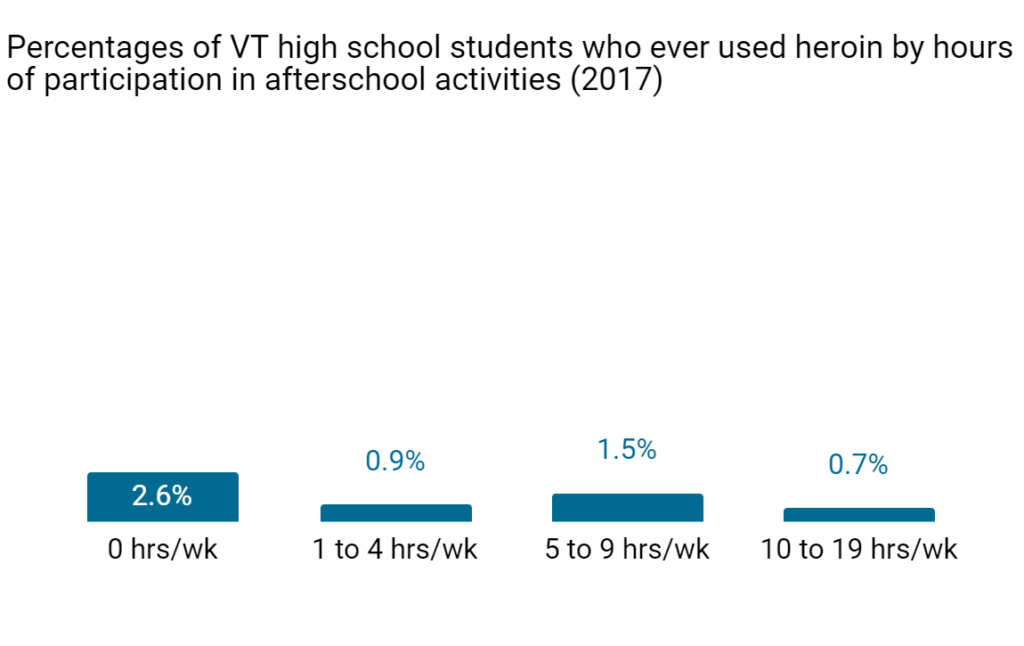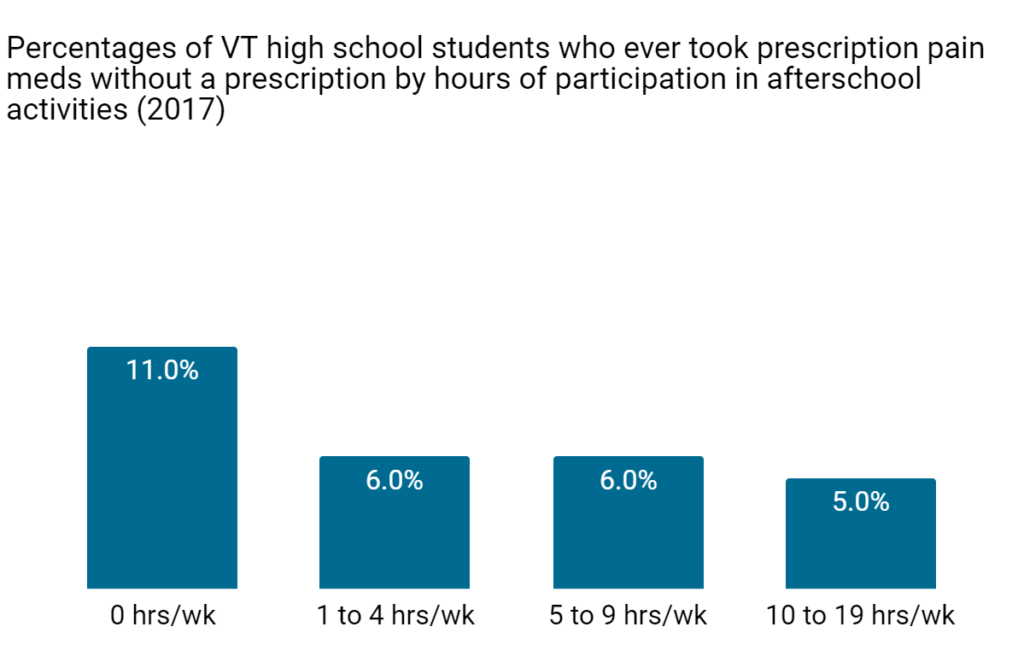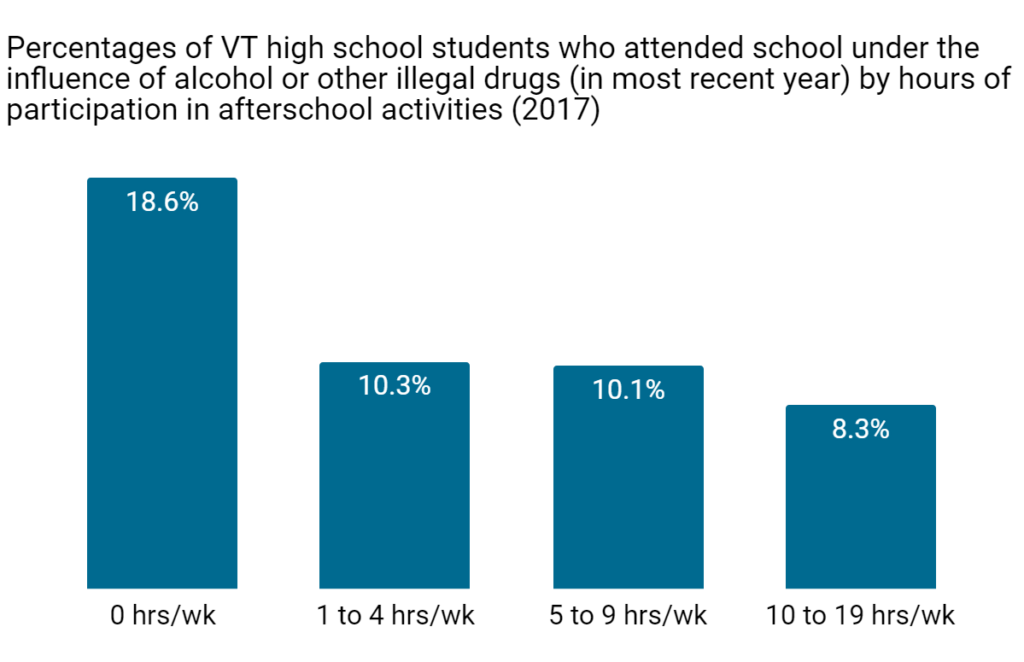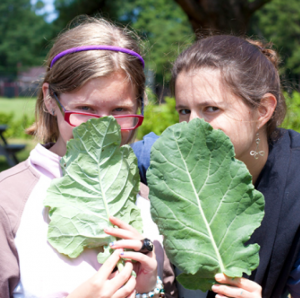Welcome to 2019! As we enter the new year, we are continuing to look at data from the most recent Youth Risk Behavior Survey (YRBS) which was completed by over 20,000 Vermont students in grades 9-12 back in the spring of 2017. The survey is administered to high school students around the state every two years, which means that in just a few months a whole new round of data will be collected. In the meantime, we still have plenty to explore from the 2017 data.
This month, we are thinking about the opioid crisis. According to the National Institute on Drug Abuse, there were 101 opioid-related deaths in Vermont in 2016. That is a rate of 18.4 deaths per 100,000 persons which was higher than the national average of 13.3 deaths per 100,000 that year. To help prevent tragic outcomes as a result of opioid dependency, Vermont Afterschool was recently awarded the Opioid Prevention Grant from the Vermont Department of Health. Through this initiative, we will work to help youth in Vermont meaningfully respond to the opioid crisis through increased afterschool programming, youth councils, and other youth engagement processes. We will also help strengthen Vermont’s ability to respond to the opioid crisis by empowering staff and practitioners working with children and youth in afterschool programs and other youth-serving organizations with awareness, skills, and resources for dealing with the crisis.
Youth need meaningful ways to build their voice, resiliency and community engagement. These skills will ultimately serve to help them decrease their risk of using and becoming addicted to substances. We have evidence from Iceland that helps support this idea. In the late 1990’s the Youth in Iceland initiative was established as a way to help youth engage in activities that would give them “natural highs” to prevent them from drinking and doing drugs. State funding for organized activities was increased and data has since been continually collected on an annual basis. Between 1997 and 2012, the percentage of Icelandic teenagers who smoked, drank, and used other drugs has been plummeting as a direct result of this initiative.
We suspect that such strategies applied in Vermont could also serve to reduce the use of opioids among high school students here. The 2017 YRBS data points to more evidence to support this hypothesis. On the survey, 20,010 students answered questions about their afterschool participation and heroin use. Among students who didn’t participate in any hours of afterschool activities, 2.6% students reported using heroine at some point in their lives. This percentage dropped to 0.9%, 1.5%, and 0.7% respectively for students who reported participating in 1 to 4 hours, 5 to 9 hours, and 10 to 19 hours of afterschool activities per week. Vermont high school students who participated in afterschool activities (up to 19 hours per week) were much less likely to have ever used heroin than those who do not participate in any afterschool activities in 2017.

The National Institute on Drug Abuse reported that according to polling data from 2002 to 2012, the incidence of heroin initiation was 19 times higher among those who reported prior non-medical pain reliever use than among those who did not. Students also responded to questions related to taking prescription pain medications (such as codeine, Vicodin, Oxycontin, Hydrocodone, and Percocet) without a prescription at some point during their lives. There were 19,988 high school students that responded to both this item and our question about participation in afterschool activities. Among those who did not participate in any hours of afterschool, 11% responded that they have used prescription pain medication without a prescription. For students who participation in up to 19 hours per week of afterschool programming, between 5% to 6% of them had reported ever using prescription pain medications without a prescription. These data show that afterschool participation is correlated with a decreased likelihood that high school students in Vermont consume opioids in the form of non-prescription pain medications.

There was also an item on the YRBS that was not specific to opioid use, but was interesting in this case because of some potential overlap. The question asked students whether they had attended school under the influence of alcohol or other illegal drugs at least once in the 12 months leading up to the survey. Among students who did not participate in any amount of afterschool activities, 18.6% responded that they did attend school under the influence in the most recent year. Among students who participated in 1 to 4 hours of afterschool activities, 10.3% reported attending school under the influence; among students who participated in 5 to 9 hours of afterschool activities, 10.1% reported attending school under the influence; and among students who participated in 10 to 19 hours of afterschool activities, 8.3% reported attending school under the influence. These percentages show that afterschool participation is correlated with a reduced likelihood that high school students in Vermont will show up to school under the influence of drugs or alcohol.

These results from the YRBS show that the opioid crisis is not limited to adults. It is imperative that we create opportunities for youth so that they have meaningful ways to become empowered and engage in activities that do not include addictive substances. We are confident that we can help Vermont reduce tragic outcomes in the long term by focusing on providing enriching opportunities for our youth today.
Read past Data Digest blog posts here:
- Afterschool participation and carrying weapons to school/school violence (Dec. 2018)
- Afterschool participation and connection with community (Nov. 2018)
- Afterschool participation and bullying (Oct. 2018)
- Afterschool participation and screen time/physical activity (Sept. 2018)
- Afterschool participation and academic performance (Aug. 2018)
- LGBT students and afterschool participation (July 2018)

